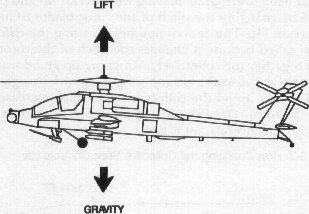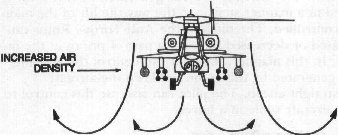Gunship Academy
by Richard Sheffield
Vertical Control
Vertical maneuvering, or moving the aircraft up and down, is done by changing the pitch of the rotor blades to increase or decrease lift. This is accomplished by using the collective stick, so called because it changes the pitch of the rotor blades together (or collectively). In going up and down, only two forces are at work: lift and weight. In order to go up, the pilot pulls up on the collective stick which increases the lift of the rotor. Once this lifting force is greater than the weight of the aircraft, up it goes.

By changing the pitch angle of the rotor with the collective stick the pilot can control the amount of lift produced and cause the aircraft to rise or fall.
When the collective is in the neutral position (top) it has a small angle-of-attack to the relative wind and as such, pressure on the top and bottom of the rotor is roughly equal. No lift is produced.
When the collective is increased (bottom), the angle-of-attack, or pitch, is increased. This causes the air pressure on the bottom of the rotor to be greater than the pressure on the top, producing lift.

A hovering helicopter is in a constant battle between gravity and lift. When lift exceeds the pull of gravity, the aircraft rises. When lift is reduced, gravity takes over and pulls the helicopter back towards the ground.
Getting the aircraft off the ground initially is aided by an effect called the ground cushion. This is what happens: Due to the strong downward force of air generated by the rotors and the closeness of the ground, the air becomes compressed, and this increased density of the air causes an increase in lift close to the ground. Once you reach a certain height, the air has room to spread out and is no longer compressed, and then more lift is needed to climb further. With the AH-64A, the ground-cushion effect goes away at an altitude of 12 feet.

As a descending helicopter approaches the ground, the downwash from the rotor blades is trapped, creating a "cushion" of denser air. This air increases the lifing ability of the rotor blades. A further decrease in the collective is necessary to land the aircraft.
To descend, the pilot pushes down on the collective stick, which decreases the pitch of the blades, causing a decrease in lift. Once the lift force is less than the weight of the helicopter, gravity does the rest, and the aircraft descends. Once close to the ground, the ground cushion may make a further decrease in the collective necessary.
Table of Contents
Previous Section: The Rotor
Next Section: The Anti-Torque Rotor
